
primary
“The goal of early childhood education should be to activate the child’s own natural desire to learn.“
- Dr. Maria MontessoriPrime Foundation Montessori's Primary Program nurtures focus, as students independently use self-correcting materials in beautiful prepared environments primed to feed their absorbent minds. At Prime Foundation Montessori a Primary class is a joyful, peaceful community of children from 2.5/3 to 6 years. Prime’s full-day program for all Primary children begins at 8:45 AM and ends at 3:15 PM. The classroom environment is carefully designed to meet the needs of students this age, who are described by Dr. Montessori as possessing “absorbent minds.” The teacher acts as a nurturing guide and facilitator. Children are given sequenced lessons designed to increase their skill and independence. Once they have been introduced to the activities and materials, children enjoy choosing their own work.
Primary children are engaged in a wide variety of work throughout the day. They may practice skills to care for themselves or the classroom or work on writing words or stories. Some children may work together to solve a large equation with manipulative math materials. Others may care for plants by watering or washing the leaves. The Montessori materials, joyfully presented and freely chosen, create a strong foundation for reading, writing, creativity, critical thinking and participation in an active, diverse community. By the time children have completed their time in Primary they have become poised, proud, and compassionate leaders for the younger children. They have learned to think for themselves, approach learning with joy, and self-regulate their emotions for social harmony.

PRIMARY curriculum
We pride ourselves in our extensive Primary Montessori curriculum. We customize individualized lessons to meet the needs of each child as every child is different and learns at a different pace. Our vast curriculum and stimulating environment promotes developmentally appropriate opportunities for learning and growth. Order, coordination, independence and concentration form the cornerstone goals of our program. Children thrive in an environment that provides the modeling behavior of older children, space for movement, and hands-on learning materials. Children choose their work from among self-correcting materials displayed on open shelves, and they work in 5 well-defined, specific areas; practical life, sensorial, language, mathematics and cultural studies. Over a period of time, the children develop into a “normalized community,” reaching a high level of concentration with few interruptions. Maria Montessori referred to “normalization” as the process through which the child progresses, from being undisciplined to self-disciplined; from disordered to ordered; from distracted to focused. This is achieved by working in a specifically prepared environment, and with repeated use of materials that captivate the child’s attention. At Prime, we strictly follow the guidelines set by Dr. Maria Montessori, as stated by Association Montessori Internationale USA.
We offer these subject areas:
Practical Life
Grace and Courtesy
Sensorial
Language
Mathematics
Cultural Studies - Geography, Social Studies, History
Science - Biology, Botany, Zoology
Art, Music and Movement
PRACTICAL LIFE
Practical Life exercises instill care for self, for others, and for the environment. Activities include many of the tasks children see as part of the daily routine in their home, such as preparing food and washing dishes, along with exercises of grace and courtesy. Through these tasks, children develop muscular coordination, enabling movement and exploration of their surroundings. They learn to work at a task from beginning to end following various action sequences and develop their powers of control and concentration. They also develop functional independence to become self-sufficient.
Practical Life exercises covers 5 main areas:
Care of self, such as learning to tie shoelaces.
Care of the environment such as watering plants.
Food Preparation such as celery slicing
Development of social relations: grace and courtesy
Coordination of physical movement.
control of movements Provoke high level of concentration.
recognize and respond to orderliness Independent care for self
Correct use of manipulative materials Independent care for environment
Large and small muscle growth Rhythmical movement with music
Improve eye-hand coordination Improve mind and body coordination

Orange Juicing

Flower Arranging
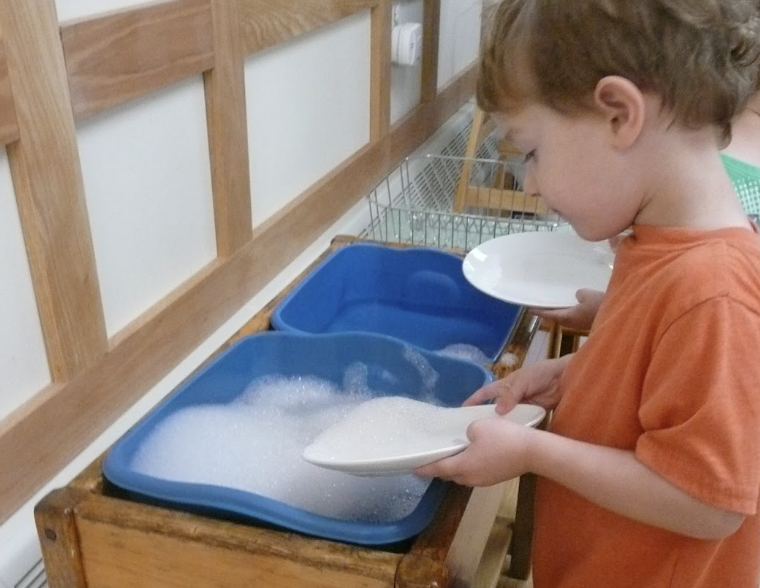
Dish Washing
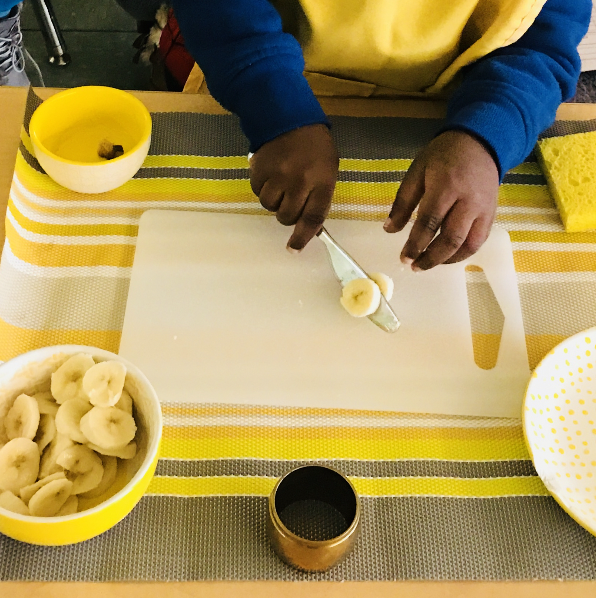
Banana Cutting
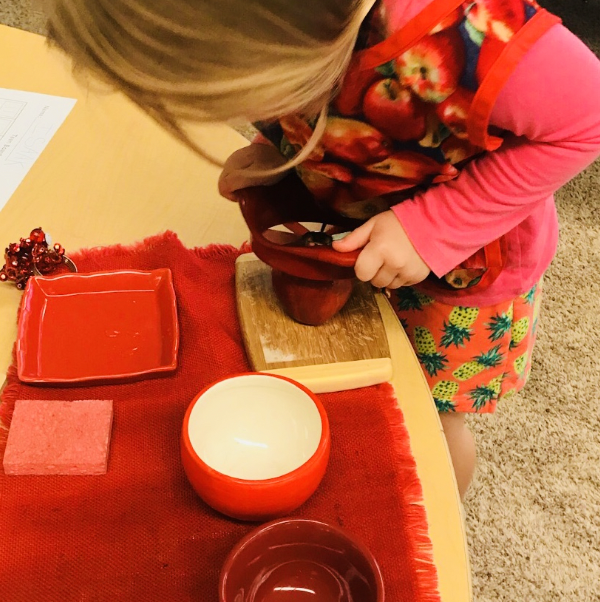
Apple Slicing
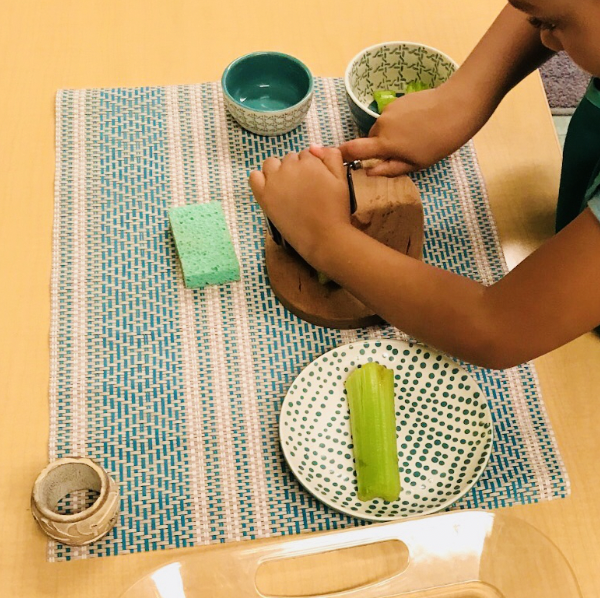
Celery Cutting
Every Montessori lesson has a purpose, a child arranges flowers to beautify his environment to develop a sense of beauty. He is developing his eye-hand coordination as well as the correct use of manipulative materials. There is also the development of his mathematical mind through the constant measurement and estimation of the volume of water transferred to and fro vessels being used in the lesson. The use of logical thinking on the measurement of the length of each flower stem before it is trimmed and put into a vase introduce the child to the concept of measurement in mathematics. The child is also building concentration and order as well as the understanding of the chronological sequence of events through the numerous steps involved in the activity. There are so many direct and indirect purposes built into every Montessori lesson or purposeful work shown to a child.
Another example is the table washing lesson. A lot of parents have wondered why their child is been shown how to wash a table. It might seem like a fruitless exercise but the truth of the matter is that there are a lot of purposes embedded in this lesson. The child is being prepared for reading and writing by the scrubbing motion going from left to right as well as the sponging motion going from left to right because we read and write from left to right. Also by utilizing the clockwise circular motion of the brush while scrubbing, we are developing the fluidity of the wrist in readiness for writing circular letters like “o”, “e”, “g”, “a”, “q”, “c”, “b” and so on. The child’s pincer grasp is being developed as he holds the brush in readiness for holding a writing tool such as a pencil. There is also the development of the mathematical mind and critical thinking skills through the constant measurement and estimation of the volume of water transferred to and fro vessels being used in the lesson. The child is building concentration, order, persistence, motivation and the understanding of chronological sequence of events by the numerous steps involved in the purposeful work. In this lesson, language is also built in by the expansion of the child’s vocabulary through the introduction of new words like, “soap surds”, “bristles” and others. There are also other indirect purposes built into this lesson.
Other purposeful activities in practical life like flour milling, cutting bananas, orange juicing, cutting celery, apple slicing, dish washing, cloth washing and many others all have inbuilt specific direct and indirect purposes to help the child in his learning, functional independence, coordination of movement and development of a high level of concentration in preparation for the proper foundational skills required for language and mathematics.
grace and courtesy
"We must help children to act for themselves, will for themselves, think for themselves; this is the art of those who aspire to serve the spirit."
- Dr. Maria Montessori
Grace and courtesy lessons are very important at this stage in a child’s development, as they are learning to function in a social environment.
SOCIAL DEVELOPMENT
SOCIAL GRACE AND MANNERS Respecting rights and property of others
Resolving conflict appropriately Expressing feelings verbally
Communicating freely with peers Relating well with peers and adults
Initiating interaction with peers offering help and empathy for others
EMOTIONAL GROWTH
These years nurture the growth of children’s independence, self-esteem, and self-discipline while introducing children to the basics of academics.
accepting new situations Exhibiting self-control
welcoming changes cooperation
handling stressful situations independence & self direction
Inner maturation positive attitude encouraged
SELF CONFIDENCE DEveloping positive self image

Proper Table Setting

Offering Help and Empathy for Others

Cooperation

Serving Tea
WORK HABITS
A child’s work habit improves and develops in various significant aspects with further exposure and utilization of the practical life purposeful activities or work.
initiating own work respecting materials
expressing joy in discovery welcoming new challenges
observing carefully exhibiting good concentration
improving memory retention increasing attention span
persisting at a task developing decision-making skills
choosing challenging work completing work cycle
learning to work without disturbing others
SENSORIAL
Sensorial materials serve as tools for development and for refinement of a child’s senses. Children build cognitive skills and learn to order and classify impressions by touching, seeing, smelling, tasting, listening, and exploring the physical properties of their environment with relation to length, width, temperature, mass, color, pitch, smell, weight, pressure etc.
Sensorial exercises cover 6 main areas:
Visual discrimination
Tactile discrimination
Olfactory discrimination
Auditory discrimination
Gustatory discrimination
Geometry and Algebra
Some of the lessons are; the constructive triangles, the geometry cabinet which includes the complete classification and nomenclature of triangles like obtuse triangle, acute triangle, isosceles triangle and so on. The geometry cabinet also includes the classified nomenclatures of geometry like quadrilaterals and polygons. Others are the geometric solids for Identification and nomenclature of geometric shapes. Knobless cylinders, textile box, pressure bottles, weight bottles, thermic tablets and so much more.

Color Tablets - Color classification for refinement of visual discrimination

Geometric Solids - Identifying geometric shapes and geometric nomenclature

Knobless Cylinders

Sensorial Exploration

Binomial Cube
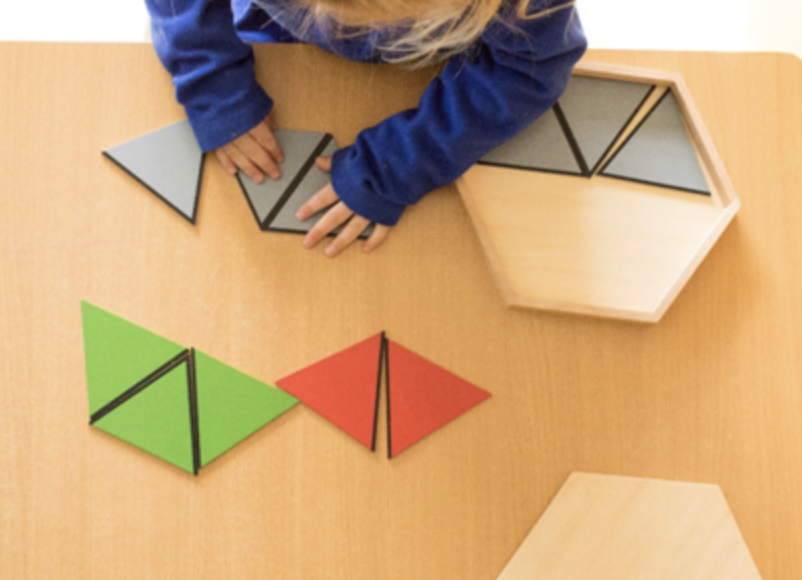
Constructive Triangles

Pink Tower

Solid Cylinder Block
lANGUAGE
Language development is vital to human development. The Montessori environment is rich in oral language opportunities, allowing the child to experience conversations, stories, and poetry. The sandpaper letters help children link sound and symbol effortlessly, encouraging the development of written expression and reading skills. To further reading development, children are exposed to the study of grammar and word study.
Language exercises cover 8 main areas:
Enrichment of vocabulary
Writing
Mechanics of writing
Reading
Reading Classification
Function of Words
Reading Analysis
Word Study
Nomenclature Puzzle Words
Conversations Reading: words, sentences, reader books
Sharing an object Children’s Literature
Stories, books, songs Initial and final consonants
Sound games Definition Stages
Sandpaper letters Pronouns, Comma
Poetry Attributes, Appositives
Matching rhyming Prefixes, Suffixes
Spelling with Moveable Alphabets Synonyms, Antonyms
Metal Insets Work Opposites
Phonetic alphabets and sounds Vowel expression of thought
Phonograms Sequencing
Writing: pencil grip, control of pencil, forms letters correctly, writes first and last name, write phonetic words, writes sentences and stories.
Editing and Publishing, Letter writing, Journaling.
Grammar: noun, article, verb, adverb, logical adverb, adjective, logical adjective, detective adjective, preposition, conjunction, interjection.

Grammar Work - Symbolization of Adverbs and Verbs

Reading a Book

Moveable Alphabet - Short Phrases

Grammar work - Working on Conjunction

Tracing Sandpaper Letters

Working on handwriting with Metal Insets
MATH
The Montessori Math Curriculum is the most advanced program available today for young children. Mathematics activities help children learn and understand the concepts of math by manipulating concrete materials. This work gives children a solid understanding of basic mathematical principles, prepares them for later abstract reasoning, and helps to develop problem-solving capabilities. Children learn that number symbols have a quantitative meaning.
Math exercises cover 5 main areas:
Numbers 1-10
Decimal System
Teens and Tens
Memorization
Passage to Abstraction
Understands quantity addition, subtraction, multiplication, division
Recognizes numerals 0-9 stamp game
Associates symbol to quantity 0-9 dot game
Counts objects to 9 snake games
Making groups of objects 0-9 strip boards
Odd and Even practice charts
teens unit boards
tens hierarchical work
linear counting - 100. 1000 short division
skip counting fractions - equivalence
Decimal System - understanding place value fractions - operations

Stamp Game: Children learn to carry out the four mathematical operations (addition, subtraction, multiplication and division) independently. This child is working on subtraction.

Bead Cabinet: For Linear Counting; learning to count 1 to 1000 and For Skip counting; learning to count e.g 1, 5, 10, 15 and multiples of numbers 1 to 10.

Decimal System Addition Work: Children learn to carry out all four mathematical operations in small groups with the golden beads material. (Addition, subtraction, multiplication & division)
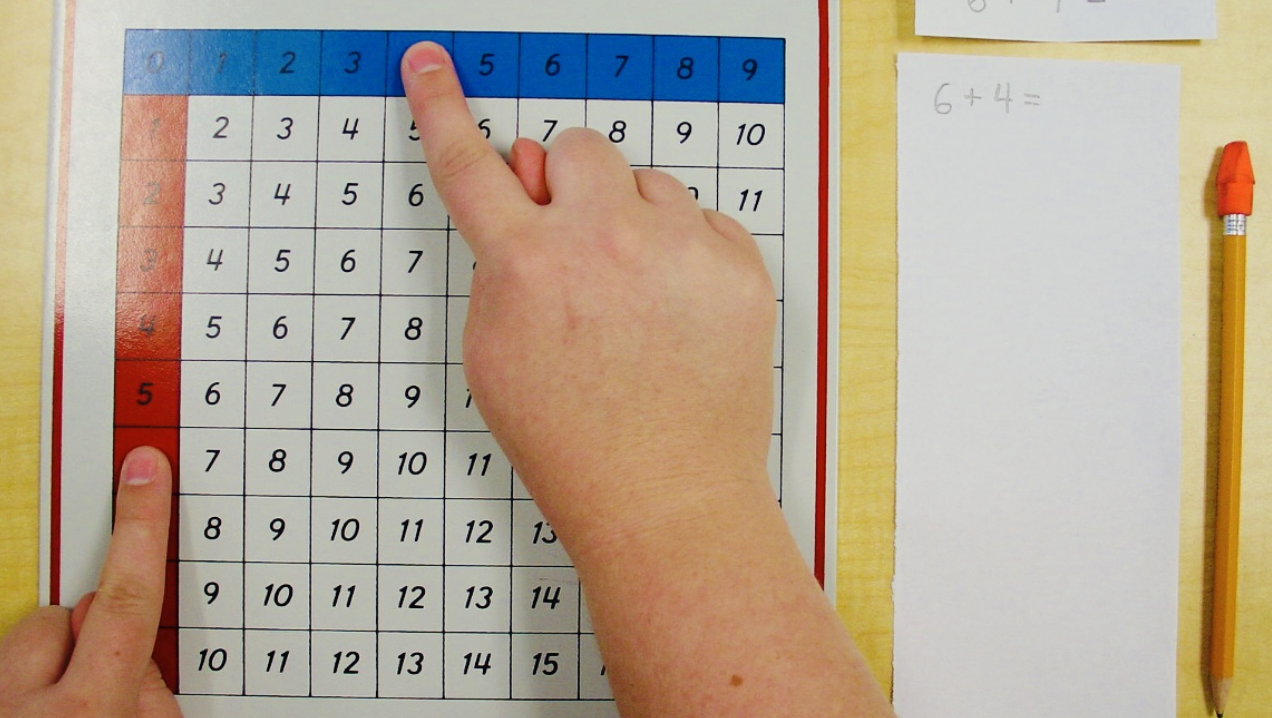
Addition Finger Chart - Children utilize this chart for Memorization of Addition Facts. There are four Addition Finger Charts, building from populated with numerals to completely blank.

Red Rods: Working on Numbers 1-10 Quantities.

Cards and Counters: Odd and Even Work
CULTURAL STUDIES
GEOGRAPHY, SOCIAL STUDIES AND HISTORY Through work with geography materials like maps, flags, globes, books and others, children will learn about different families, cultures, foods, practices, clothes, and languages that are part of our world. Primary students invite families to share their different cultural beliefs on different cultural holidays. The children will work with the puzzle maps, beginning with the world map and then exploring the different continents.
Exploration of land and water forms provides a sensorial experience of the world around them. Cultural stories enrich the child’s language and experience of what is outside of their immediate world. Exploration of geography is interdisciplinary, many of the geography materials have a link to social studies and history, and these aspects are part of the child’s world!
During their time in the Primary, students explore different cultures in many ways. In geography, students explore different languages, dress, and traditions celebrated around the world. Music is another way Primary students explore culture. From singing songs in different languages and from around the world, students not only learn about language but also about the country it came from. Parents are invited to come in during the year and share their culture and traditions.
History and Social studies are presented as extensions of the sensorial and language activities. Children learn about people and cultures in other countries with an attitude of respect and admiration. Through familiarity, children come to feel connected to the global human family. Lessons and experiences with nature inspire a reverence for all life.

Working on Puzzle Maps of Countries

Working on Continent Map

Working with continent globe.

Montessori Flags
science
BIOLOGY, BOTANY AND ZOOLOGYAn important element in the development of the child’s personality is the actual contact he has with reality and his ability to involve himself in it. The freedom enjoyed by the child in the prepared environment allows him to experiment, observe, manipulate, receive, explore, perceive, discover, and classify. When Maria Montessori talks about Natural Sciences, she does not refer to the knowledge of natural phenomena, but rather to an inner relationship with Nature.
The Primary child will begin their exploration of science with materials like the botany cabinet – where they will trace different leaf shapes, and learn the names of the leaves (nomenclature). The child will experience the parts of the plant and flower through dissection activities. The child will explore biology by naming and labeling animals, animal anatomy, life cycle curriculum, nature study, using simple scientific tools, equipments and vocabulary, and through our reading materials. The Primary child experiences the natural world through activities like flower arranging, plant care, and even filling the bird feeder!
This introduction to the natural world guides the child to an understanding and knowledge of what fills our planet.

Nature Study with Magnifiers

Parts of the Pumpkin.

Tadpoles for Life Cycle of a Frog.

Plant Samples for a Herbarium
Art, music and movement
Daily time on the playground provides a useful outlet for the Primary child’s endless energy while helping his or her body to gain greater coordination, strength, and health.
In addition to the playground with climbing structures, slides and swings, the Primary children sometimes enjoy supervised nature walks around our community, giving them the opportunity to learn from the natural outdoor environment around them.
The comprehensive art and music curriculum give children every opportunity to enjoy a variety of creative activities, as well as gain knowledge of the great masters. Drawing, painting, singing and dance are incorporated into daily classroom activities.
Along with art appreciation, children in the Primary environment develop an appreciation for music. The Bells are a musical piece of material in the sensorial area. The bells help the child to develop a sense of tone and pitch discrimination. They will mix and match the bells, compose their own tunes and eventually read and write music. The children will be exposed to different composers and types of music through listening activities. Children will take part in group singing often. Singing is a group activity that creates a sense of community!

Playing The Bells

Poster Painting

Hand Painting

Paper Weaving
schedule a visit now
We are thrilled to invite you to visit our school and witness firsthand the exceptional educational experience we offer. Our exceptional faculty and top-notch facilities eagerly await the opportunity to show you the outstanding quality of education we provide.
Take a minute to schedule a visit now by clicking below.
Come see the difference we make!